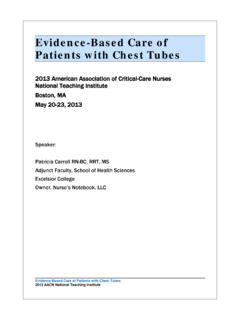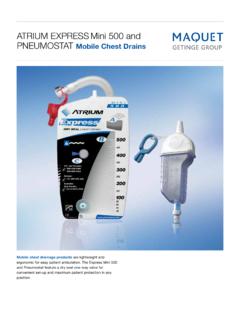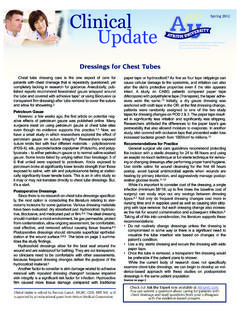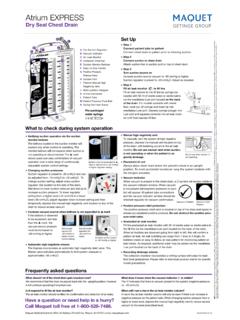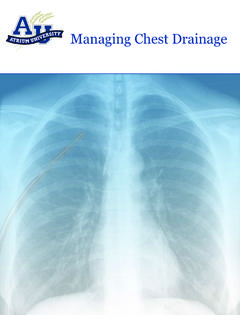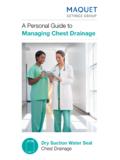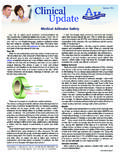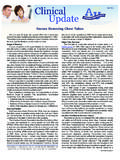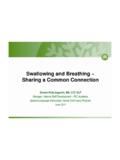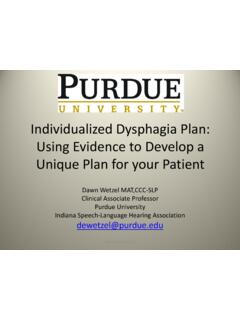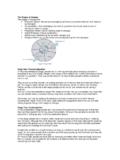Transcription of Satisfied Patients are Money in the Bank - Atrium …
1 Since this is such an important topic, we have doubled thelength of our feature in this issue. In the Literatureand On theWebare on page often express frustration at the administrators focus on patient satisfaction because their focus is on of satisfaction can be seen as simply evaluations ofhow nice people are, and most nurses know at least one gruffsurgeon with no bedside manner that they would choose forthemselves or a loved one who needed complicated , satisfaction is big business. A report from PressGaney noted that one standard deviation improvement in quali-ty score resulted in a 2% increase in operating margin and that30% of the variance in hospital profitability can be attributed topatients perceptions of , beginning in October 2012,Medicare reimbursement to hospitals will be tied to patient sat-isfaction an average of $500,000 to $850,000 at risk annuallyper 2006, hospitals have been required to col-lect and submit data or lose 2% of reimbursement.
2 In October,hospitals must meet certain thresholds of achievement orimprovement to get full reimbursement. The amount at risk willincrease in coming years. HCAHPSThe Consumer Assessment of Healthcare Providers andSystems (CAHPS) started as an assessment of health plansthrough the Agency for Healthcare Research and Quality (AHRQ).The name was changed in 2005 to reflect applications across caresettings. HCAHPS is the hospital survey. It was implemented byCMS in October 2006, and public reports started in March 2008( ). HCAHPS goes together with the quality indica-tors also publicly reported that currently focus on MI, heart fail-ure, pneumonia, and surgical care (SCIP). These indicators will bemodified; those for which hospitals are close to 100% will be refinedand others updated as evidence evolves. A hospital s total perform-ance score determining reimbursement will be 30% HCAHPS and70% quality measures. (See On the Webfor online resources forthese tools and to see publicly reported data.)
3 While patient satisfaction is gaining attention now because of thedirect link to payment, there are other key, measurable benefits ofhaving Satisfied Patients . These include: improved volume relatedto reputation in the community, patient loyalty, reduced malpracticeclaims, more Satisfied staff and physicians (and decreased turnoverwith related costs), and improved efficiency. One hospital linked sat-isfaction improvement to $ million in additional Things Affect Patient Perceptions As clinicians, we can think about satisfaction as we have learnedto assess pain: it is what the patient says it is. Unlike quality indica-tors that are objectively evaluated through chart reviews, satisfac-tion is all about patient perception. And these perceptions are aresult of their expectations. Some experts are concerned that theseexpectations result in bias on HCAHPS because hospitals in theSouth and Midwest have more Satisfied Patients than those in theNortheast. In addition, small hospitals that transfer complex patientsscore higher than hospitals with more than 500 beds, and hospitalswith high patient ratings have higher mortality hasshown differences in the patient experience based on patient age,race/ethnicity, education, and health status.
4 Self-ranked health sta-tus was most significant; one-third of hospitals ranked in the middle(50th percentile) by an average patient in good health would differby at least 19 percentile points for Patients who rank their health atthe extremes as excellent or poor. Differences between patientswith post-baccalaureate education and those who didn t attend highschool were similar to differences between Patients aged 25 andaged study of satisfaction with surgery at 26 hospitals found thatyounger Patients were less Satisfied , as were those admittedthrough the emergency department. Patients who believed theirstay was the right length were more Satisfied than those whothought their stay was too long. Post-discharge complicationsresulted in significantly lower satisfaction scores, even if the ques-tions did not relate directly to the complication. The strongest andmost consistent predictors of dissatisfaction were treatment out-come, kindness of caregivers, and length of consideration when exploring HCAHPS scores is whatdrives the patient s hospital choice.
5 The best hospital for relativelyhealthy Patients may not be the best for complex, ill mind that all adult Patients are surveyed for hospitals that receiveMedicare payments not just the Medicare Patients . The expecta-tions and experiences of healthy OB Patients are going to be verydifferent from those of a 70-year-old cardiac surgery patient. Alsothink about how well a hospital meets the needs of Patients whoseprimary language is not English, and those with different culturalhealth practices. Patients best experiences tend to come from hos- Satisfied Patients are Money in the BankClinical Update is edited by Patricia Carroll, RN,BC, CEN, RRT, MS. andsupported by an educational grant from Atrium Medical 2012 Quality Indicators Relating to Cardiac Surgery Preoperative antibiotic within one hour of surgery Postoperative antibiotic stopped within 24 hours Appropriate antibiotic chosen VTE prophylaxis ordered and implemented Glucose controlled postoperatively Hair removed with clippers Surgical Patients who were on a beta blocker preopreceived postop Urinary catheter removed by POD 2 Participate in data registryWinter 2012pitals in which they are members of the hospital s typical way the HCAHPS survey is conducted will also impactresults in two ways: who responds and who doesn t, and theanswers people provide.
6 Hospitals typically hire companies to con-duct surveys, and they have four options: mail, mail with telephonefollow up, telephone interview, and voice response interviews provide more positive evaluations, but are sig-nificantly more expensive to bottom line is that Patients assume people in hospitals knowwhat they are doing. They take the quality for granted unless thereis a reason not to, and a poor surgical outcome is a significant indi-cation of poor quality to the layman. Otherwise, Patients don t feelqualified to judge the finer points of , food quality,cleanliness, and noise are surrogates of quality that Patients feelcomfortable evaluating along with whether clinicians cared aboutthem. Perceptions and Satisfaction After Cardiac SurgeryStudies have shown that Patients illness beliefs have a greatimpact on outcomes, and outcomes affect satisfaction. Beliefs areclosely related to fear, anger, and distress. A study of cardiac sur-gery Patients discovered that illness beliefs predicted disability,physical functioning, and depression post-op, even after controllingfor cardiac variables; it was patient expectations that affected (See On the Webfor a link to the tool.)
7 A few studies have examined the patient experience to betterprepare them and to set realistic discharge interviewed Patients recoveryissues were energy level; chest incision; sleeping; and shoulder,neck and back muscle discomfort. Researchers discovered thesesensations changed between discharge, 2 days later, and 3 weekslater, and that the Patients descriptions were markedly differentfrom those used by clinicians. A Hong Kong study11found depres-sion and physical activity impairment peaked at one week, withrecovery by three months and gradual improvement continuedthrough six months. An Australian study interviewed Patients about their surgery andrecovery experience six months after , patientsdescribed sensations they had not been prepared for: pain relatedto immobility (particularly stiffness and muscle pain), and inability tosleep. Patients also expressed the life-changing nature of the sur-gery some said it made them realize what s important and whatisn t, but others felt their age more and believed they were closer todeath.
8 Most recalled being sick, reaching a turning point, and thenfeeling better. The researchers stress the importance of realistic andconsistent messages for study interviewed Patients about their surgery experi-ence one year main theme was the quality of the con-tact with clinicians, but Patients emphasized the positive relation-ships they had with other Patients and those families during the hos-pitalization. In fact, male Patients preferred sharing a room withother cardiac surgery Patients ; it provided not only camaraderie, butalso a feeling of safety. In the program studied, there was no routinecontact from the hospital department after discharge. Patientsexpressed a desire to be able to contact nurses who had cared forthem in the hospital, perhaps with special call hours to minimizeinterruptions for the nurses. Patients found other Patients could helpthem know what was normal during recovery, which reduced postdischarge anxiety and established realistic expectations.
9 You can see how not only the care provided in the hospital, butalso the expectations of normal sensations and experiences dur-ing recovery that are set at discharge in addition to the timing of theHCAHPS survey completion can have a big impact on and colleagues noted that patient satisfaction with carecan be influenced by the person's health status at the time of Cardiac Surgery SatisfactionNurses can have a big impact on satisfaction scores after cardiacsurgery. The literature tells us the most important aspect is ensuringthat Patients have a thorough understanding of what to expect withregard to physical sensations, psychosocial responses, and thetimeframe of ,7-11 Nurses have traditionally done a goodjob explaining what Patients need to do risk reduction, medica-tions, and diet but Patients have expressed a need for moredetailed information about what they are likely to feel both physi-cally and emotionally.
10 There needs to be regular contact followingdischarge for at least the first three months postoperatively sincephysical, social and emotional recovery rates vary during that study of CABG Patients found that a comprehensive pre- andpostoperative education program, including postdischarge tele-phone follow-up (averaging 133 minutes total per patient) signifi-cantly improved self-care scores and behaviors and reduced painintensity, anorexia, respiratory difficulty, leg swelling, constipation,and number of ER visits than Patients in the control group thatreceived routine may seem like an extraordinaryamount of time until you consider the cost of poor HCAHPS surgery, assessing beliefs related to heart disease pro-vides the opportunity to correct misconceptions and reset expecta-tions. This can provide significant dividends during recovery andwhen Patients think about whether they were Satisfied with theircare and whether it met their Press Ganey: Return on investment: increasing profitability by improving patient satis-faction.
